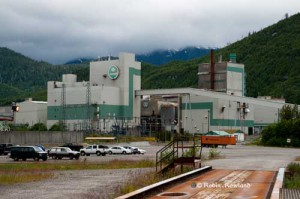
The Kitimat Modernization Project, the $3.3 billion upgrade of the Kitimat aluminum smelter will create capable and competitive contractors that can go on to work at the future energy developments in the region, Rio Tinto Alcan CEO Jacynthe Côté said Thursday, March 8.
Côté was in Kitimat to tour the region, a trip that was postponed in December, at the time of the “Notice to Proceed” on the modernization project, when her aircraft was diverted to Prince Rupert by a snow and sleet storm the day of the announcement.
During a dinner on Wednesday night, Côté met with leading contractors, the leaders of the Haisla First Nation, Mayor Joanne Monaghan and members of the District of Kitimat Council.
The prospect of future energy projects, three liquified natural gas terminals to be built by the KM LNG partners, by the BC LNG partnership and by Shell was one factor in Rio Tinto Alcan giving the go ahead for the modernization project, she told local reporters.
“We have seen the critical mass in other parts of the world, “she said. “One of the reason to do full speed in December was to aim that we will be ramping down as the others are ramping up. Of course, I cannot say for the other projects that will be their decision.” Given the current schedules, she said, “we should be out of the way when others pick up.” (Another key reason for the go ahead, according to RTA primary metal vice president Jean Simon, speaking at the launch last December was the growing market for aluminum in Asia)
Côté added that the contractors now have “great abilities that could be redeployed.”
Michel Lamarre, Director of KMP said that despite some delays due to the harsh winter, RTA is still aiming for first concrete at the new potlines on June 1. First new metal is scheduled for the second quarter of 2014. Peak employment, about 2,500 people, is expected to be in the first quarter of 2013.
“We have the ambition to make the project a real showcase, for us, for British Columbia, for Canada,” Côté said. “So we’re pretty proud that 62 per cent of the work done so far has been done by the community in the area., 95 per cent of them in British Columbia, which is absolutely spectacular for a project of that complexity and magnitude.
“It requires a lot of skills, a lot of organization.”
Côté said she stressed RTA’s safety priorities when she met with the local contractors (a point the company made both at the Notice to Proceed gathering in December and at a local meeting for contractors last month). The contractors are very enthusiastic, Côté said. “I’ve seen in other regions as contractor and employees moved to that level of safety performance, it becomes a competitive edge, there’s going to be other projects coming in the region, there’s a lot of discussion around LNG, and it will be an advantage for contractors who have demonstrated superior performance and safety. We’re here to support that. I think they’re going to be more compelling and competitive, I mean it’s good business.”
She says that RTA is spending $3.1 million each day on the modernization project.
Asked about both the prospective LNG projects and the fact that accommodation in Kitimat is now at a premium, she said that “crowding” was a significant part of her discussions with both the Haisla and the District of Kitimat.
Rio Tinto has worked on what she called “disproportionately big” projects at sites compared to local communities around the world. “So we adjust, my message was we adjust.[There are] Different formulas in different parts of the world, depending on the conditions. The model is to bring in as many people from the community as we can.”


